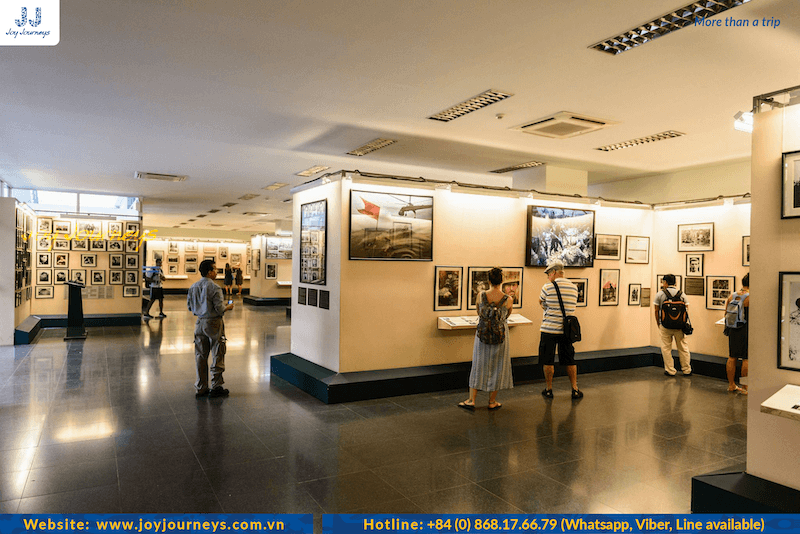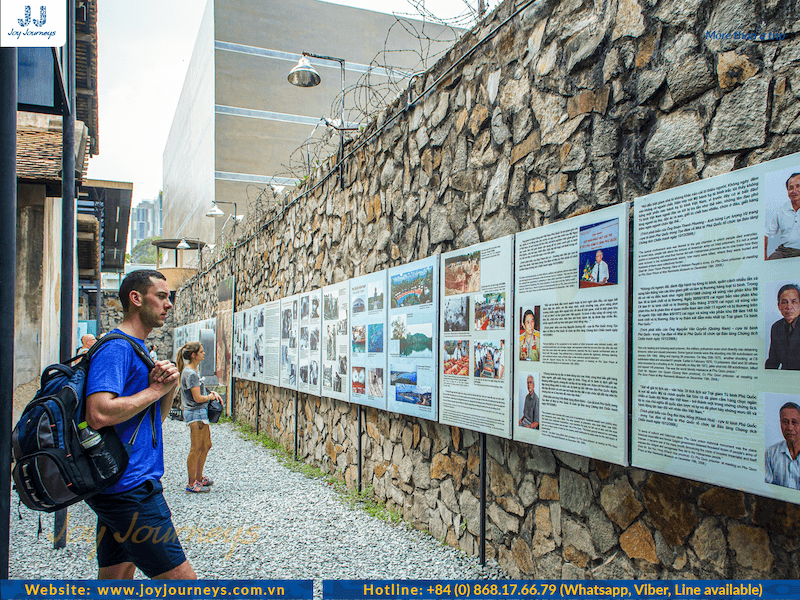The War Remnants Museum stands as one of Ho Chi Minh City’s most significant and emotionally powerful attractions. For travelers seeking to understand Vietnam’s complex history and the lasting impact of the Vietnam War, visiting war remnants museum offers an unforgettable and sobering experience that provides crucial context to modern Vietnamese society.
Contents
- 1 Preparing for Your Visiting War Remnants Museum: An Essential Introduction
- 2 What to Expect: A Walkthrough of the Exhibits
- 3 Practical Information for Your Visit
- 4 Is Visiting War Remnants Museum Suitable for Children?
- 5 Tips for Visiting War Remnants Museum
- 6 FAQs About Visiting War Remnants Museum
- 7 Explore Vietnam’s Rich History with Joy Journeys
- 8 Conclusion
Preparing for Your Visiting War Remnants Museum: An Essential Introduction
The War Remnants Museum, known locally as Bảo tàng Chứng tích Chiến tranh, is dedicated to documenting the Vietnam War—or as it’s known in Vietnam, the “American War.” This Vietnam war museum serves a critical purpose: to showcase the horrors and consequences of war from a Vietnamese perspective, presenting an unfiltered narrative that may differ significantly from Western accounts of the conflict.
Before planning your visit, it’s essential to understand that this is not a conventional museum experience. The exhibits are designed to be powerful, graphic, and emotionally challenging. The war remnants museum emotional impact is intentional and profound, featuring disturbing images of war casualties, chemical weapon effects, and civilian suffering. Visitors should prepare themselves mentally for content that can be deeply unsettling but historically significant.
The museum’s approach is direct and uncompromising, aiming to educate visitors about the true cost of war while advocating for peace. This perspective makes it one of the most important history museums Saigon has to offer, providing essential context for understanding Vietnam’s modern development and international relations.

What to Expect: A Walkthrough of the Exhibits
Understanding what’s inside the war remnants museum will help you prepare for your visit and maximize your learning experience. The museum is thoughtfully structured across multiple floors with extensive outdoor exhibits, each section telling a different aspect of the war story through military hardware, historical documents, and deeply personal photographic evidence.
Outdoor Exhibits (Military Hardware)
Your war remnants museum experience begins in the museum’s courtyard, where an impressive collection of captured American military equipment awaits. This outdoor area features tanks, helicopters, fighter jets, and artillery pieces—all actual vehicles used during the conflict. These tangible remnants of war provide a powerful introduction to the scale and intensity of the fighting.
The aircraft display includes iconic helicopters like the UH-1 “Huey” and fighter jets such as the F-5A Freedom Fighter. Visitors can walk around these machines, reading detailed placards that explain their roles in the conflict. For many visitors, seeing these massive war machines up close provides their first real sense of the war’s magnitude.
One of the most haunting and significant displays at the war remnants museum is the Tiger Cage exhibit—a replica of the brutal wire-enclosed cells used at Con Dao Prison. These cramped, barbed-wire cages vividly recreate the harrowing conditions where political prisoners were confined in solitary darkness, forced to stoop or lie in spaces scarcely larger than a meter—places once described as “hell on earth”.
The Ground Floor (The “Big Picture”)
The ground floor exhibitions focus on international perspectives and general war history. Here, you’ll find displays documenting international support for Vietnam’s struggle for independence, including photographs and artifacts from anti-war movements around the world. This section helps contextualize the conflict within the broader Cold War era and demonstrates the global nature of opposition to the war.
The Upper Floors (Thematic & Photographic Exhibits)
The upper floors contain the museum’s most impactful and disturbing content. This is where the guide to war remnants museum becomes most important, as these floors require emotional preparation. The exhibitions are organized thematically, covering topics such as “Aggression War Crimes,” the devastating effects of Agent Orange, and the work of international war photographers who documented the conflict.
The Agent Orange exhibition is particularly harrowing, featuring photographs and preserved specimens showing the chemical’s effects on both the environment and human health. The work of renowned war photographers, including those who died covering the conflict, provides stark visual testimony to the war’s brutality and human cost.

Practical Information for Your Visit
Location & How to Get There
The War Remnants Museum is conveniently located at 28 Vo Van Tan Street, Xuan Hoa Ward, Ho Chi Minh City. This central location makes it easily accessible from most Ho Chi Minh City attractions. The museum is within walking distance of the city center and can be reached by taxi, motorbike taxi, or on foot from nearby landmarks like the Independence Palace.
For those using public transportation, numerous bus routes serve the area, and the museum is clearly marked on most tourist maps. The central location means you can easily combine your museum visit with other historical sites in the area.
Opening Hours & Ticket Information
Current war remnants museum opening hours are daily from 7:30 AM to 5:30 PM, including weekends and public holidays. However, the ticket counter closes at 5:00 PM, so plan to arrive with sufficient time for your visit. Some sources indicate varying closing times, so it’s advisable to arrive before 4:30 PM to ensure entry.
War remnants museum tickets are reasonably priced, making this educational experience accessible to all travelers. As of 2025, adult admission costs 40,000 VND (approximately $1.52 USD), while children aged 6-15 pay 20,000 VND (approximately $0.76 USD). Children under 6 enjoy free admission. These affordable prices reflect Vietnam’s commitment to making this important historical site accessible to international visitors.

Is Visiting War Remnants Museum Suitable for Children?
This frequently asked question deserves careful consideration. The answer largely depends on the child’s age, maturity level, and ability to process difficult historical content. The museum’s graphic nature raises important questions about is war remnants museum suitable for kids.
The outdoor exhibits featuring military hardware are generally appropriate for older children and can be educational without being traumatic. However, the upper floors contain highly graphic photographs and exhibits depicting war casualties, chemical weapon effects, and civilian suffering that may be disturbing for children and sensitive adults.
For families visiting with children, consider this strategy: explore the outdoor military exhibits together, which offer historical education without graphic content. Parents can then take turns visiting the indoor galleries while the other stays with children in the courtyard or nearby café areas. This approach allows adults to experience the full museum while protecting younger visitors from potentially traumatic content.
Tips for Visiting War Remnants Museum
Planning tips for visiting war remnants museum can enhance your experience while ensuring you approach this sensitive site with appropriate respect. First and foremost, allow adequate time for your visit. The question of how long to spend at war remnants museum is crucial—most visitors need 2-3 hours to fully absorb the exhibits without rushing.
Understanding what to see at war remnants museum helps you prepare for the different exhibits. Take your time reading the detailed captions and explanations provided throughout the museum. These provide crucial historical context and help visitors understand the significance of what they’re seeing. The museum’s narrative is carefully constructed to educate rather than simply shock, so engaging with the written materials enhances understanding.
Be emotionally prepared for a challenging experience. It’s completely normal to feel overwhelmed, sad, or disturbed by what you see. Consider planning a quiet activity afterward—perhaps a peaceful walk through a nearby park or a reflective coffee break—to process your thoughts and emotions.
Maintain respectful behavior throughout your visit. This means speaking quietly, not taking photos where prohibited, and being mindful of other visitors who may also be having emotional responses to the exhibits. Remember that for many Vietnamese visitors, these exhibits represent personal or family history.

FAQs About Visiting War Remnants Museum
Are photographs allowed inside the museum?
Photography policies vary by section. Generally, photos are allowed in outdoor areas and some indoor spaces, but flash photography is prohibited, and some sensitive exhibits restrict photography entirely. Check for posted signs and ask staff if unsure.
Is there a dress code?
While there’s no strict dress code, visitors should dress modestly and respectfully as befitting a historical memorial site. Avoid wearing clothing with political slogans or military insignia that might be considered insensitive.
Are there guided tours available?
The museum offers audio guides in multiple languages, and various tour operators provide guided visits. Having a knowledgeable guide can significantly enhance your understanding of the exhibits’ historical context.
Is the museum wheelchair accessible?
The museum has made improvements to accessibility, with ramps and elevators available, though some areas may still present challenges for mobility-impaired visitors. Contact the museum directly for specific accessibility information.
Explore Vietnam’s Rich History with Joy Journeys
To truly understand the War Remnants Museum within the broader context of Ho Chi Minh City’s history and culture, consider joining a comprehensive guided tour. Joy Journeys offers the “Highlights of Saigon with Culture & History 1-Day City Tour”, a thoughtfully curated experience that includes the War Remnants Museum alongside other significant historical sites.
This exclusive small-group tour (limited to 10 participants) provides personalized service from expert English-speaking guides who can offer deeper insights into Vietnam’s complex history. The tour combines the War Remnants Museum with visits to iconic sites like the Saigon Notre Dame Cathedral, Central Post Office, Independence Palace, and unique locations like the Hidden Weapon Bunker—a Vietcong soldiers’ bunker hidden in the heart of Saigon.
What sets this tour apart is its comprehensive approach to Vietnamese history and culture. Beyond the war narrative, visitors explore Cao Dai Temple (representing Vietnam’s unique unified religion), Van Phat Pagoda (showcasing Chinese Buddhist influence), and a traditional handicraft lacquerware workshop. This balanced perspective helps visitors understand Vietnam’s rich cultural heritage alongside its challenging history.
The tour includes all entrance fees, transportation in an air-conditioned vehicle, water, and a traditional Vietnamese lunch, making it an excellent value for travelers wanting to maximize their understanding of Ho Chi Minh City’s historical significance.
Conclusion
Visiting War Remnants Museum represents more than just a tourist activity—it’s an essential educational experience for understanding modern Vietnamese history and the lasting impacts of conflict. While challenging and emotionally demanding, the museum provides invaluable insights into Vietnam’s perspective on one of the 20th century’s most significant conflicts.

The museum’s powerful exhibits, from outdoor military hardware to deeply personal photographic testimonies, create a comprehensive narrative that encourages reflection on the costs of war and the importance of peace. For travelers seeking to understand Vietnam beyond its natural beauty and culinary delights, the War Remnants Museum offers crucial historical context that illuminates the resilience and determination of the Vietnamese people.
Plan your visit to this important museum with adequate time and emotional preparation. Whether visiting independently or as part of a comprehensive historical tour with providers like Joy Journeys, the War Remnants Museum will undoubtedly leave a lasting impression and deeper appreciation for Vietnam’s complex history and remarkable recovery.
Remember, this is more than a museum—it’s a memorial, a teacher, and an advocate for peace. Approach it with respect, open-mindedness, and a willingness to confront difficult truths about the cost of conflict and the value of understanding different perspectives on shared history.



Related Posts
Saigon’s “Flower Market Replica”: Where To Find Them
Ho Chi Minh City’s floral charm is not limited to its bustling wholesale markets. Imagine wandering through a place where vibrant petals, fragrant blooms, and the spirit of traditional Vietnamese markets come alive—without the overwhelming crowds. A flower market replica captures that magic, blending the beauty of fresh flowers with the charm of a curated, […]
Is it Safe to Travel to Vietnam Right Now? A Complete 2025 Guide
Vietnam has emerged as one of Southeast Asia’s most captivating destinations, drawing millions of visitors annually with its rich culture, stunning landscapes, and incredible cuisine. However, many travelers still ask: Is it safe to travel to Vietnam right now? This comprehensive guide provides you with everything you need to know about Vietnam travel safety in […]
Ho Chi Minh Cu Chi Tunnels Tour: The Ultimate Guide
The Cu Chi Tunnels stand as one of Vietnam’s most remarkable historical sites, offering visitors a profound glimpse into the ingenuity and resilience displayed during the Vietnam War. For travelers, a Ho Chi Minh Cu Chi tunnels tour represents an essential experience that combines education, adventure, and deep cultural understanding. This comprehensive guide will help […]